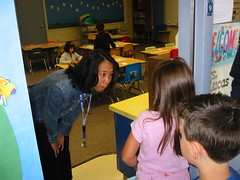
The sound of roaring engines filled the streets of downtown San Jose last weekend, as the city played host to the inaugural San Jose Grand Prix. I took Friday off and volunteered for the Sports Car Club of America (SCCA) as a course marshal. I’ve been interested in auto racing since I was a kid, when my dad would take me to races at Laguna Seca in Monterey and Sears Point (now Infineon Raceway) in Sonoma. I finally did something about it and joined the San Francisco Region of the SCCA earlier this summer.
I got in touch with the chief marshal for SCCA SFR a month or so ago and he was gracious enough to include me in one of the biggest motor sports events of the year here in the Bay Area. As a course marshal, I was responsible for helping setup the course prior to the day’s events. This included distributing fire extinguishers, oil dry and brooms to the numerous flagging stations around the 1.6 mile race course.
The marshaling crew is also responsible for cleaning up the race course if an accident occurs. So they have a truck that hauls seven course marshals out to the accident. Four ride in the cab, while three are tethered to the tailgate by lap harnesses. Ridding around the track while sitting on that tailgate is quite the experience.

When I signed up for marshaling, I thought I was signing up for flagging duty. Flagging requires a set of volunteers to message the car drivers of certain race conditions using colored flags. Yellow means “caution” as an example. A blue flag with a yellow stripe means “heed to the faster car that’s trying to pass you”.
As it turns out, marshaling and flagging are two different things, so I didn’t end up volunteering for the job I had intended. Given that mix up, I still had a blast marshaling. The marshaling had more than enough volunteers for the weekend, so I bowed out on Saturday.
The marshaling crew was stationed in one of the paddocks, which allowed me to checkout many of the cars that were participating during the weekend. The Trans Am series (and eventual race winner), featured Boris Said, who serves as a road racing specialist on the NASCAR tour. Boris spent most of Friday morning sitting next to all the marshals in the paddock while the race organizers tried to figure out how to make the Light Rail tracks that crossed the track n two places smoother for the cars.
One of the benefits of volunteering is that you receive a race credential as well as a guest credential for the weekend. Since I wasn’t working on the rig any longer, I called my dad to see if he wanted to check out the race.
It just so happened that he was heading back into town specifically to see the race, so we hooked up and were able to catch much of the action.

The event itself was hailed as a major success for the City of San Jose, but from my perspective, the viewing locations for spectators were lousy. I’d prefer to see a race at Laguna Seca. The promoters did a great job of luring fans to the event, but I’m curious to see how the attendance fares next year.
Dad and I staked out a spot on the corner of Park and Market, which served as the race track’s 6th turn. The course itself was very tight, and as a result we saw a few cars fly into the tire barrier that covered the concrete wall exiting turn 6.
The only passing that occurred in the main event took place on pit row, because the track itself offered few places to overtake other cars. So in the end the pole winner, Sebastian Bourdais, led for a majority of the race, and was never really challenged by his next closest competitor.
After all the smoke cleared, I give the event a B-. The city was decked out and handled the crowds very well, but the racing itself was mediocre. Hopefully they gets those kinks worked out next year. Until then, I’ll be watching my racing down on the Monterey Peninsula.
Checkout my
[Race Photos] on Flickr




























